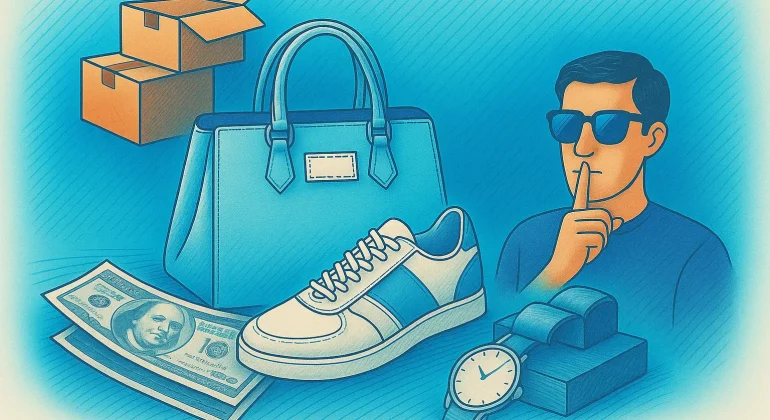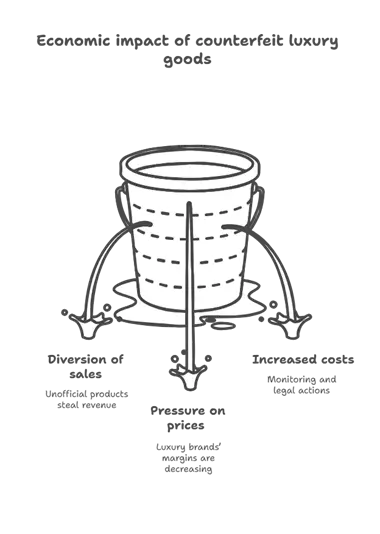Sommaire
Introduction
We are witnessing the emergence of an unprecedented phenomenon in luxury goods counterfeiting: Pingti. These high-end replicas reproduce the materials, design, and finishes of iconic models with precision, yet bear no logo or visible brand name. They attract consumers seeking discretion and affordable prestige, while undermining traditional brand protection strategies and posing new legal challenges.
What is a Pingti?
Definition and characteristics
The term “Pingti” originates from Mandarin and can be translated as “decoy” or “sophisticated fake.” It refers to ultra-realistic reproductions of luxury goods that:
• Faithfully replicate the design, proportions, and finishes of the original items;
• Often use the same materials, or materials of equivalent quality;
• Are sometimes manufactured in the same factories as the originals, outside official production lines;
• Bear no logo, brand name, or protected distinctive sign, making legal identification more complex;
• Align with the “quiet luxury” trend, favouring discreet elegance and recognition through design rather than a displayed brand.
Consumer appeal
Sold at prices up to ten times lower than the originals, Pingti appeal to consumers seeking the quality and prestige of luxury goods without paying full price. Their spread is amplified by social media platforms such as TikTok, comparative videos, and specialised forums.
Legal grey area
In the absence of a brand affixed to them, Pingti often escape the scope of traditional counterfeiting laws. However, when they reproduce a design protected by a registered design right or copyright, they may be subject to sanctions. Their legal classification therefore largely depends on the type of protection held over the copied product.
Risks associated with Pingti
Erosion of exclusivity
By multiplying visually similar imitations, Pingti undermine the unique and exclusive character of luxury goods.
Economic impact
• Diverting part of sales towards non-official products;
• Putting downward pressure on prices and margins for luxury houses;
• Increasing monitoring and litigation costs.
Brand image risks
The association of an iconic design with a lower-priced product, even of good quality, diminishes the prestige and perceived value of the brand.
Strategies to combat Pingti
Strengthening intellectual property rights
Registering designs protects the aesthetic appearance of products. This is an effective and swift tool within the European Union.
Complementary legal tools
In certain cases, copyright can protect original creations. Patents may secure technical innovations incorporated into products.
Strict supplier contracts
Exclusivity and confidentiality clauses must be included in manufacturing contracts to limit the risk of design diversion.
Legal actions not based on trademarks
Even without a brand affixed, actions may be brought on the grounds of unfair competition, parasitism, or harm to reputation.
Market monitoring and customs intervention
Implementing monitoring systems on marketplaces and working with customs authorities helps detect and intercept these products before they reach the market.
Conclusion
Fighting Pingti requires an approach that combines legal protection, contractual vigilance, and active market surveillance. Luxury brands must act in a coordinated manner to preserve their exclusivity, protect their image, and anticipate new forms of counterfeiting.
Dreyfus Law firm assists its clients in managing complex intellectual property cases, offering personalized advice and comprehensive operational support for the complete protection of intellectual property.
Dreyfus Law firm is partnered with a global network of lawyers specializing in intellectual property.
Nathalie Dreyfus with the assistance of the entire Dreyfus team.
FAQ
1. What exactly is a Pingti?
A luxury product reproduced identically in its materials and design, but without any logo or visible brand.
2. What is the difference between a “dupe” and a classic counterfeit?
A Pingti aims for a quality almost identical to the original, whereas a “dupe” is an openly lower-quality imitation, and a classic counterfeit also reproduces the brand.
3. Can action be taken without a logo or visible brand?
Yes, through design registrations, copyright protection, or actions for unfair competition and parasitism.
4. What legal tools are most effective against Pingti?
Design registrations, copyright, unfair competition laws, and customs enforcement.
5. How can Pingti be monitored and quickly addressed?
By combining active monitoring of marketplaces, automated alerts, and immediate takedown procedures.


